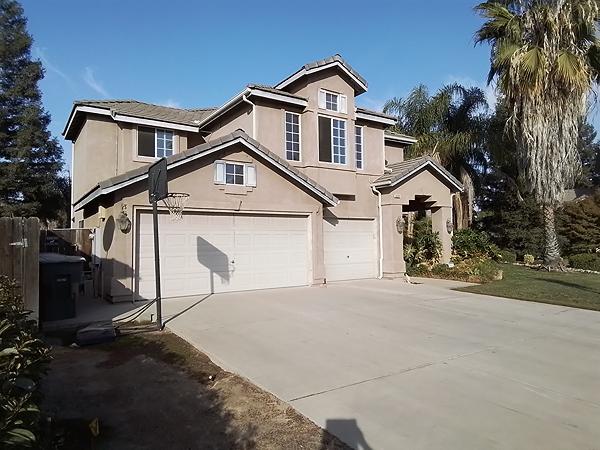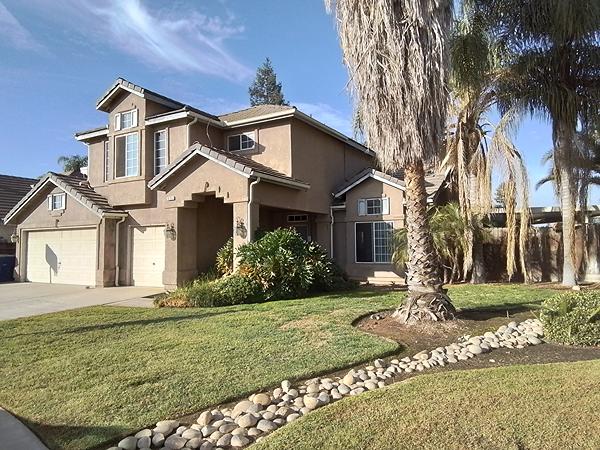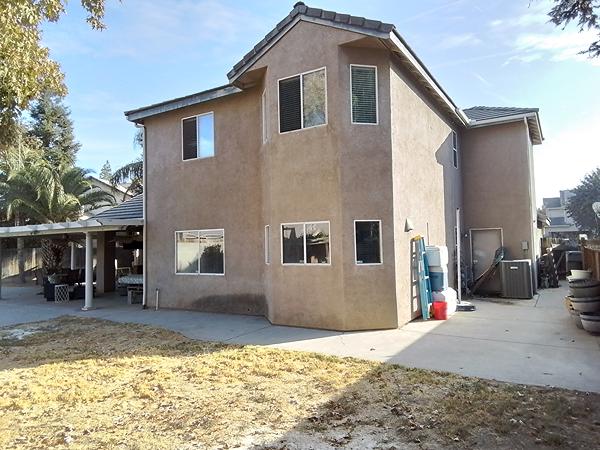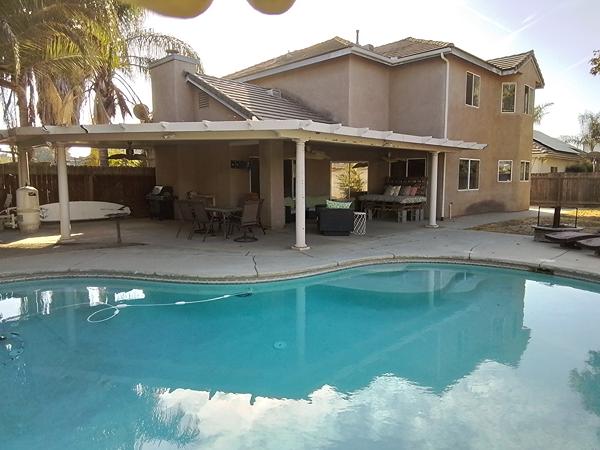Sherlock Home Inspections
(559) 696-4436
Inspector: Curt Rolff
Inspector's email: crolff4@att.net
NACHI15032712
California
California




Summary
| Client(s): | Leffingwell |
| Property address: | 8205 N Bond St Fresno CA 93720-2181 |
| Inspection date: | Friday, October 25, 2024 |
This report published on Saturday, October 26, 2024 11:55:48 AM PDT
This report is the exclusive property of Sherlock Home Inspections and the client(s) listed in the report title. Use of this report by any unauthorized persons is prohibited.
| Safety | Poses a safety hazard | |
| Repair/Replace | Recommend repairing or replacing | |
| Repair/Maintain | Recommend repair and/or maintenance | |
| Maintain | Recommend ongoing maintenance | |
| Evaluate | Recommend evaluation by a specialist | |
| Monitor | Recommend monitoring in the future | |
| Serviceable | Item or component is in serviceable condition | |
| Comment | For your information |
Grounds
2) 
 Cracks, holes, settlement, heaving and/or deterioration resulting in trip hazards were found in the sidewalks or patios. For safety reasons, recommend that a qualified contractor repair as necessary to eliminate trip hazards.
Cracks, holes, settlement, heaving and/or deterioration resulting in trip hazards were found in the sidewalks or patios. For safety reasons, recommend that a qualified contractor repair as necessary to eliminate trip hazards.
Exterior and Foundation
3)  Cracks, deterioration and/or damage were found in one or more areas of the exterior stucco finish. In damp climates, moisture can enter cracks or damaged areas and further deteriorate the stucco. Also the wall behind the stucco can become damaged from moisture. Note that areas behind the stucco are inaccessible and excluded from this inspection. Recommend that a qualified contractor repair or replace stucco as necessary.
Cracks, deterioration and/or damage were found in one or more areas of the exterior stucco finish. In damp climates, moisture can enter cracks or damaged areas and further deteriorate the stucco. Also the wall behind the stucco can become damaged from moisture. Note that areas behind the stucco are inaccessible and excluded from this inspection. Recommend that a qualified contractor repair or replace stucco as necessary.
4)  The paint or stain finish in some areas was failing (e.g. peeling, faded, worn, thinning). Siding and trim with a failing finish can be damaged by moisture. Recommend that a qualified contractor prep (e.g. clean, scrape, sand, prime, caulk) and repaint or restain the building exterior where necessary and per standard building practices. Any repairs needed to the siding or trim should be made prior to this.
The paint or stain finish in some areas was failing (e.g. peeling, faded, worn, thinning). Siding and trim with a failing finish can be damaged by moisture. Recommend that a qualified contractor prep (e.g. clean, scrape, sand, prime, caulk) and repaint or restain the building exterior where necessary and per standard building practices. Any repairs needed to the siding or trim should be made prior to this.
Roof
5)  Some concrete roof tiles were broken and/or loose. Leaks may occur as a result. This is a conducive condition for wood-destroying organisms. Recommend that a qualified person replace tiles or make repairs as necessary.
Some concrete roof tiles were broken and/or loose. Leaks may occur as a result. This is a conducive condition for wood-destroying organisms. Recommend that a qualified person replace tiles or make repairs as necessary.
Attic and Roof Structure
7) 
 Attic spaces greater than 30 inches in height appeared to exist in this building, but no access points were found. Standard building practices require that access points be installed for attic spaces more than 30 inches in height for periodic evaluation. Recommend that a qualified person install attic access points where missing and per standard building practices (e.g. adequate size, insulated, weatherstripped). A qualified person should fully evaluate these attic spaces and roof structures. These areas are excluded from this inspection.
Attic spaces greater than 30 inches in height appeared to exist in this building, but no access points were found. Standard building practices require that access points be installed for attic spaces more than 30 inches in height for periodic evaluation. Recommend that a qualified person install attic access points where missing and per standard building practices (e.g. adequate size, insulated, weatherstripped). A qualified person should fully evaluate these attic spaces and roof structures. These areas are excluded from this inspection.
Lower attic space, above garage.
Lower attic space, above garage.
Garage or Carport
9) 
 One or more automatic door openers were substandard. Recommend that a qualified contractor evaluate and repair or replace opener(s) as necessary.
One or more automatic door openers were substandard. Recommend that a qualified contractor evaluate and repair or replace opener(s) as necessary.
10) 
 One or more garage vehicle doors were difficult or unable to open or close. Vehicle doors should open and close smoothly and easily. A qualified person should evaluate and repair as necessary. This may require lubrication or repair to hardware such as rollers or brackets.
One or more garage vehicle doors were difficult or unable to open or close. Vehicle doors should open and close smoothly and easily. A qualified person should evaluate and repair as necessary. This may require lubrication or repair to hardware such as rollers or brackets.
Electric
12) 

 One or more electric receptacles at the exterior had no visible ground fault circuit interrupter (GFCI) protection, or the inspector was unable to determine if GFCI protection was present. If not GFCI-protected, receptacles in wet areas pose a shock hazard. Recommend that a qualified electrician evaluate and install GFCI protection if necessary and per standard building practices. General guidelines for GFCI-protected receptacles include the following locations:
One or more electric receptacles at the exterior had no visible ground fault circuit interrupter (GFCI) protection, or the inspector was unable to determine if GFCI protection was present. If not GFCI-protected, receptacles in wet areas pose a shock hazard. Recommend that a qualified electrician evaluate and install GFCI protection if necessary and per standard building practices. General guidelines for GFCI-protected receptacles include the following locations:
https://www.reporthost.com/?GFCI
- Outdoors (since 1973)
- Bathrooms (since 1975)
- Garages (since 1978)
- Kitchens (since 1987)
- Crawl spaces and unfinished basements (since 1990)
- Wet bar sinks (since 1993)
- Laundry and utility sinks (since 2005)
https://www.reporthost.com/?GFCI
13) 
 For home buyers, batteries in all the smoke alarms should be replaced after taking occupancy. Batteries should be replaced annually in the future. "Chirping" noises emitted from smoke alarms typically indicate that batteries need replacing. For more information, visit:
For home buyers, batteries in all the smoke alarms should be replaced after taking occupancy. Batteries should be replaced annually in the future. "Chirping" noises emitted from smoke alarms typically indicate that batteries need replacing. For more information, visit:
https://www.reporthost.com/?SMKALRM
At least 2 alarms chirp after testing.
https://www.reporthost.com/?SMKALRM
At least 2 alarms chirp after testing.
Water Heater
15) 
 The estimated useful life for most water heaters is 8-12 years. This water heater appeared to be beyond this age and/or its useful lifespan and may need replacing at any time. Recommend budgeting for a replacement in the near future, or considering replacement now before any leaks occur. The client should be aware that significant flooding can occur if the water heater fails. If not replaced now, consider having a qualified person install a catch pan and drain or a water alarm to help prevent damage if water does leak.
The estimated useful life for most water heaters is 8-12 years. This water heater appeared to be beyond this age and/or its useful lifespan and may need replacing at any time. Recommend budgeting for a replacement in the near future, or considering replacement now before any leaks occur. The client should be aware that significant flooding can occur if the water heater fails. If not replaced now, consider having a qualified person install a catch pan and drain or a water alarm to help prevent damage if water does leak.
16)  The temperature-pressure relief valve was leaking. Recommend that a qualified plumber repair as necessary. For example, by replacing the valve.
The temperature-pressure relief valve was leaking. Recommend that a qualified plumber repair as necessary. For example, by replacing the valve.
Heating, Ventilation and Air Condition (HVAC)
17)  One or more heating or cooling ducts have come apart, or had significant gaps at junctions. This can result in reduced energy efficiency and increased moisture in surrounding spaces. Recommend that a qualified HVAC contractor make permanent repairs as necessary. For example, by securely supporting ducts and installing approved tape or mastic at seams.
One or more heating or cooling ducts have come apart, or had significant gaps at junctions. This can result in reduced energy efficiency and increased moisture in surrounding spaces. Recommend that a qualified HVAC contractor make permanent repairs as necessary. For example, by securely supporting ducts and installing approved tape or mastic at seams.
18)  Recommend that home buyers replace or clean HVAC filters upon taking occupancy depending on the type of filters installed. Regardless of the type, recommend checking filters monthly in the future and replacing or cleaning them as necessary. How frequently they need replacing or cleaning depends on the type and quality of the filter, how the system is configured (e.g. always on vs. "Auto"), and on environmental factors (e.g. pets, smoking, frequency of house cleaning, number of occupants, the season).
Recommend that home buyers replace or clean HVAC filters upon taking occupancy depending on the type of filters installed. Regardless of the type, recommend checking filters monthly in the future and replacing or cleaning them as necessary. How frequently they need replacing or cleaning depends on the type and quality of the filter, how the system is configured (e.g. always on vs. "Auto"), and on environmental factors (e.g. pets, smoking, frequency of house cleaning, number of occupants, the season).
Kitchen
20) 
 The dishwasher appeared to be malfunctioning. Recommend that a qualified specialist evaluate and repair or replace as necessary.
The dishwasher appeared to be malfunctioning. Recommend that a qualified specialist evaluate and repair or replace as necessary.
Bathrooms, Laundry and Sinks
22)  One or more sink drains were leaking at location(s) #A and B. A qualified person should repair as necessary.
One or more sink drains were leaking at location(s) #A and B. A qualified person should repair as necessary.
Left sink
Left sink
23)  The wall by the shower at location(s) #B was water-damaged. Recommend that a qualified person repair as necessary.
The wall by the shower at location(s) #B was water-damaged. Recommend that a qualified person repair as necessary.
24)  Baseboards damaged by exposure to moisture
Baseboards damaged by exposure to moisture
Interior, Doors and Windows
26) 
 Carpeting in one or more areas was loose and posed a trip hazard. Recommend that a qualified contractor repair as necessary. For example, by stretching or replacing carpeting.
Carpeting in one or more areas was loose and posed a trip hazard. Recommend that a qualified contractor repair as necessary. For example, by stretching or replacing carpeting.
27) 

 Stains were found in one or more ceiling areas. The inspector was unable to determine if an active leak exists (e.g. recent dry weather, inaccessible height). Recommend asking the property owner about this, monitoring the stains in the future, and/or having a qualified contractor evaluate and repair if necessary.
Stains were found in one or more ceiling areas. The inspector was unable to determine if an active leak exists (e.g. recent dry weather, inaccessible height). Recommend asking the property owner about this, monitoring the stains in the future, and/or having a qualified contractor evaluate and repair if necessary.
28) 
 Condensation or staining was visible between multi-pane glass in one or more windows. This usually indicates that the seal between the panes of glass has failed or that the desiccant material that absorbs moisture is saturated. As a result, the view through the window may be obscured, the window's R-value will be reduced, and accumulated condensation may leak into the wall structure below. Recommend that a qualified contractor evaluate and repair windows as necessary. Usually, this means replacing the glass in window frames.
Condensation or staining was visible between multi-pane glass in one or more windows. This usually indicates that the seal between the panes of glass has failed or that the desiccant material that absorbs moisture is saturated. As a result, the view through the window may be obscured, the window's R-value will be reduced, and accumulated condensation may leak into the wall structure below. Recommend that a qualified contractor evaluate and repair windows as necessary. Usually, this means replacing the glass in window frames.
Be aware that evidence of failed seals or desiccant may be more or less visible depending on the temperature, humidity, sunlight, etc. Windows or glass-paneled doors other than those that the inspector identified may also have failed seals and need glass replaced. It is beyond the scope of this inspection to identify every window with failed seals or desiccant.
Be aware that evidence of failed seals or desiccant may be more or less visible depending on the temperature, humidity, sunlight, etc. Windows or glass-paneled doors other than those that the inspector identified may also have failed seals and need glass replaced. It is beyond the scope of this inspection to identify every window with failed seals or desiccant.
29) 
 Wood flooring in one or more areas was cupping and/or swollen. This may indicate that the floor has been exposed to water or that the flooring was not allowed to equalize in moisture content before being installed. Consult with the property owner and/or have a qualified specialist evaluate. It's likely that affected areas of the wood flooring will need to be refinished to obtain a flat surface. For more information, visit:
Wood flooring in one or more areas was cupping and/or swollen. This may indicate that the floor has been exposed to water or that the flooring was not allowed to equalize in moisture content before being installed. Consult with the property owner and/or have a qualified specialist evaluate. It's likely that affected areas of the wood flooring will need to be refinished to obtain a flat surface. For more information, visit:
https://www.reporthost.com/?WDFLRPRB
https://www.reporthost.com/?WDFLRPRB
30) 
 One or more exterior doors had minor damage and/or deterioration. Although serviceable, the client may wish to repair or replace such doors for appearances' sake.
One or more exterior doors had minor damage and/or deterioration. Although serviceable, the client may wish to repair or replace such doors for appearances' sake.
Pool
31) 
 Pool does not contain 2 of the 7 required safety features as stipulated in California Senate Bill 442.
Pool does not contain 2 of the 7 required safety features as stipulated in California Senate Bill 442.
Safety features that comply with the new law, as outlined in Senate Bill 442:
1) An enclosure that isolates the swimming pool or spa from the private single-family home.
2) Removable mesh fencing that meets American Society for Testing and Materials (ASTM) Specifications F2286 standards in conjunction with a gate that is self-closing and self-latching and can accommodate a key lockable device.
3) An approved safety pool cover
4) Exit alarms on the private single-family home’s doors that provide direct access to the swimming pool or spa. The exit alarm may cause either an alarm noise or a verbal warning, such as a repeating notification that “the door to the pool is open.”
5) A self-closing, self-latching device with a release mechanism placed no lower than 54 inches above the floor on the private single-family home’s doors providing direct access to the swimming pool or spa.
6) An alarm that, when placed in a swimming pool or spa, will sound upon detection of accidental or unauthorized entrance into the water. The alarm shall meet and be independently certified to the ASTM Standard F2208 “Standard Safety Specification for Residential Pool Alarms,” which includes surface motion, pressure, sonar, laser, and infrared type alarms. A swimming protection alarm feature designed for individual use, including an alarm attached to a child that sounds when the child exceeds a certain distance or becomes submerged in water, is not a qualifying drowning prevention safety feature.
7) Other means of protection, if the degree of protection afforded is equal to or greater than that afforded by any of the features set forth above and has been independently verified by an approved testing laboratory as meeting standards for those features established by the ASTM or the American Society of Mechanical Engineers (ASME).
Safety features that comply with the new law, as outlined in Senate Bill 442:
1) An enclosure that isolates the swimming pool or spa from the private single-family home.
2) Removable mesh fencing that meets American Society for Testing and Materials (ASTM) Specifications F2286 standards in conjunction with a gate that is self-closing and self-latching and can accommodate a key lockable device.
3) An approved safety pool cover
4) Exit alarms on the private single-family home’s doors that provide direct access to the swimming pool or spa. The exit alarm may cause either an alarm noise or a verbal warning, such as a repeating notification that “the door to the pool is open.”
5) A self-closing, self-latching device with a release mechanism placed no lower than 54 inches above the floor on the private single-family home’s doors providing direct access to the swimming pool or spa.
6) An alarm that, when placed in a swimming pool or spa, will sound upon detection of accidental or unauthorized entrance into the water. The alarm shall meet and be independently certified to the ASTM Standard F2208 “Standard Safety Specification for Residential Pool Alarms,” which includes surface motion, pressure, sonar, laser, and infrared type alarms. A swimming protection alarm feature designed for individual use, including an alarm attached to a child that sounds when the child exceeds a certain distance or becomes submerged in water, is not a qualifying drowning prevention safety feature.
7) Other means of protection, if the degree of protection afforded is equal to or greater than that afforded by any of the features set forth above and has been independently verified by an approved testing laboratory as meeting standards for those features established by the ASTM or the American Society of Mechanical Engineers (ASME).
General Disclaimer
32) 
 This report and inspection does not address and is not intended to address the possible presence of or danger from any potentially harmful substances and environmental hazards including but not limited to radon gas, asbestos, lead paint, mold, urea formaldehyde, flammable or toxic chemicals and water and airborne hazards. Also excluded are inspections and reports on wells, swimming pools, septic and sewer systems, security systems, fire sprinkler and detection systems, lawn sprinkler systems, central vacuum systems, and water softeners.
This report and inspection does not address and is not intended to address the possible presence of or danger from any potentially harmful substances and environmental hazards including but not limited to radon gas, asbestos, lead paint, mold, urea formaldehyde, flammable or toxic chemicals and water and airborne hazards. Also excluded are inspections and reports on wells, swimming pools, septic and sewer systems, security systems, fire sprinkler and detection systems, lawn sprinkler systems, central vacuum systems, and water softeners.
